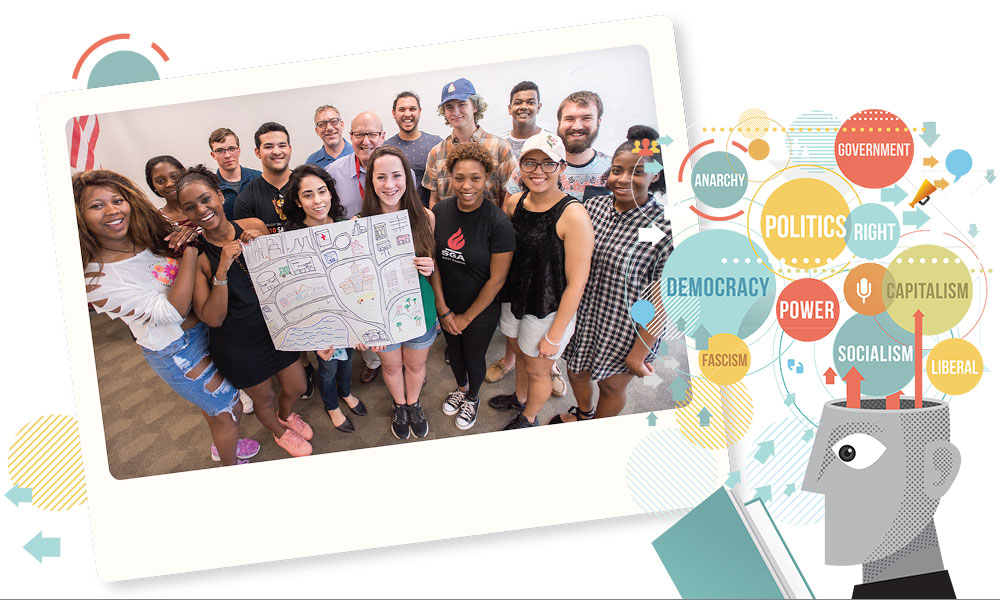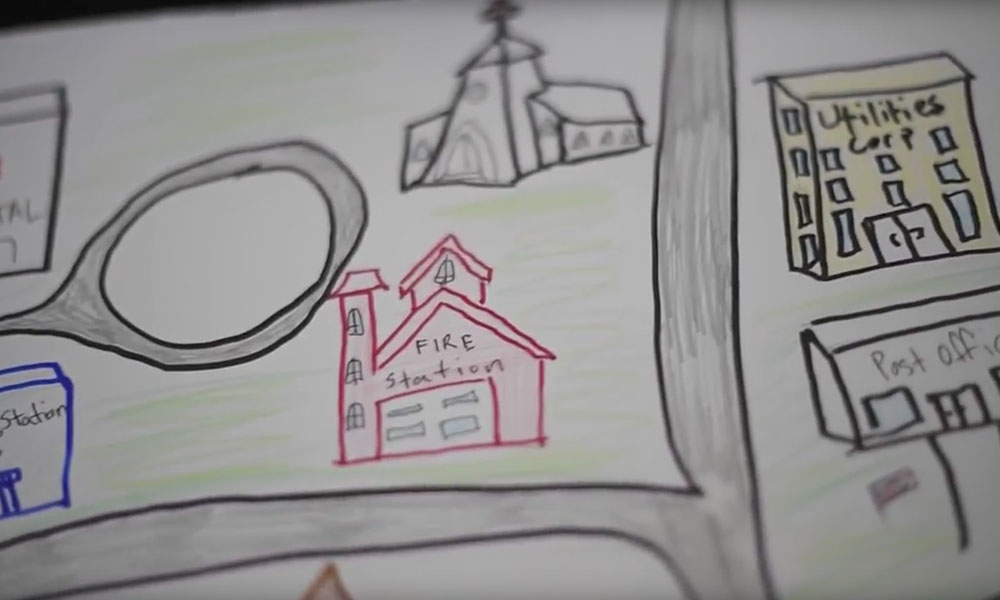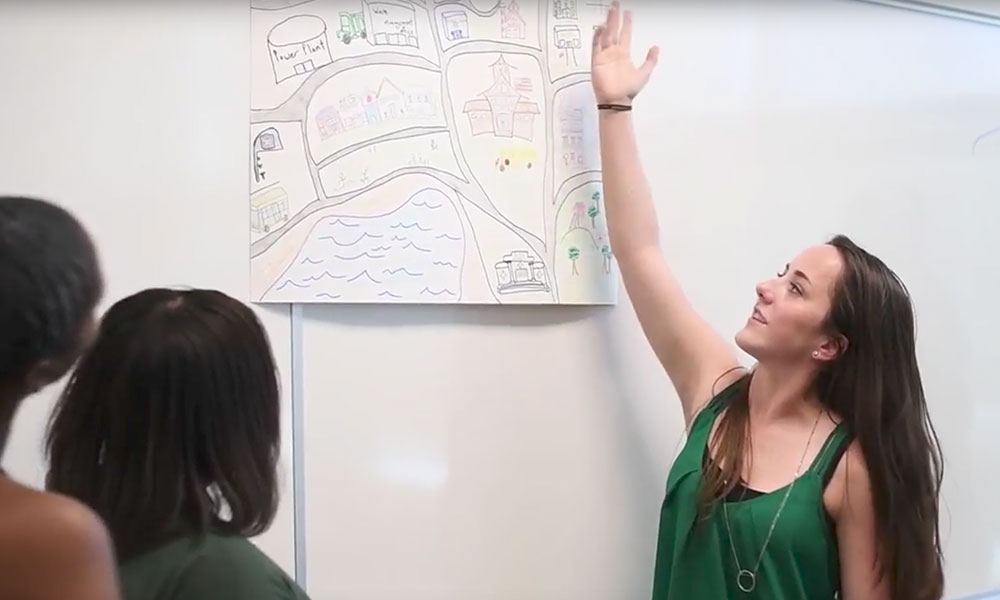Many of them were fresh out of graduate school, eager for jobs and the opportunity to teach—even “In the Christmas of 1967, Valencia was in the middle of its first year, and I walked into the campus on Oak Ridge Road and told them I’m looking for a job in the next academic year,” says Stanley Melnick. “Here’s my resume and I had a letter from my commanding officer, who was a general at the time.” Melnick was hired in fall of 1968 and retired from Valencia in 2005. Today, he teaches political science as an adjunct on Valencia’s West Campus. Melnick, who had earned his bachelor’s and master’s degrees at Florida State University, didn’t come directly to Valencia from FSU. Instead, he got drafted to serve in the Marine Corps. But he never went abroad—instead, the Marines’ brass sent Melnick, who’d flunked out of Officer Candidate School, to Quantico, Va., where he was assigned to the Marine Corps Command and Staff College. “I was in charge of running the audio-visual section for all the officers who were the instructors,” recalls Melnick. “We would have ambassadors come in, the Joint Chiefs of Staff, all the people who would give presentations. I was in charge of making sure that all the slides and films went on as they were supposed to. It was a neat job.” At one point, his superiors offered him the chance to go back to Officer Candidate School. Melnick declined the offer. “The only time I shot a weapon,” he notes, “was in training.” After serving for his required two years, Melnick applied for teaching jobs at community colleges throughout Florida. He landed a job at Daytona State Community College in early 1968 and, after a few months, Valencia called with a job offer. Melnick, who’d majored in political science and minored in sociology, first began teaching sociology. “I was just a young whippersnapper. I was 23,” he said. “Some of the students were older than I was. I wanted to look older, so I grew a beard to look older.” He quickly bonded with the other faculty members – who came from a variety of backgrounds. Some, like Julia Ribley, had just earned their master’s degrees and had been job hunting at the 26 new community colleges throughout the state; others were veteran teachers from Orlando Junior College and local high schools. “It was fun back there. You were starting something unique,” he says. “Everybody was gung ho.” So when Valencia began building its first campus on Kirkman Road, the faculty and staff were thrilled. “It was out in the boondocks in the beginning. Kirkman was just a two-lane road, built specifically to get workers to the Martin Plant from Pine Hills. But south of Winter Garden Road, there was nothing,” recalled Melnick. When the West Campus opened for classes in 1971, Building 1 housed the library, labs and administrative offices. The classrooms were in portables. Melnick and his wife bought a house in Pine Hills and raised their kids there. In the 1970s, he earned his doctorate through a program offered to community college professors through NOVA Southeastern University. “It took me four years to do it, but it was one of the best decisions I ever made,” he notes. “So I have a feeling for what students who are working part-time or full-time go through as they try to earn a degree.” For Melnick, just as the students, Valencia represented opportunity. Over the years, he has traveled to Europe, Russia, Eastern Europe, China and Costa Rica, to study international politics. But one of his most memorable experiences came in 1980, when he participated in a faculty exchange with Mount Royal University in Calgary, Alberta, Canada—and taught sociology. “I traveled up with my wife and my kids and I taught sociology classes,” recalls Melnick. “It was He was having so much fun that he extended the exchange for another year. “Valencia auditors called me up in Canada and said, ‘Are you really there?’” Over time, Valencia’s student body has changed, but the college’s mission remains the same, says Melnick. “It’s an opportunity for students to get a quality education close to home,” he says, “and “Everybody has an opportunity to do well. That’s what Valencia offers, it doesn’t mean everyone’s going to do well,” he says. “Valencia is wonderful; it hasn’t changed.” Walk into Stanley Melnick’s class on state and local government (that’s POS 2112 for those of you who are registering) and you may soon find yourself transported to the imaginary town of Melville. There, in Melville, students learn how local government works, thanks to Melnick’s fictional town. Frankly, he says, it makes learning about government a lot more interesting than a dry textbook. “I develop a town called Melville and I tell the students, ‘You’re going to be a part of it. You’re going to be on the city council.” Students must present their vision of what Melville looks like – and describe how zoning can shape the town. The point, he says, is to get them to really think about the role of local government. When soda taxes made the news, Melnick told the students that the Melville City County had proposed a soda tax. But the students had to create the rationale for why the town needed a soda tax. Meanwhile, other students will represent the American Beverage Association and they must argue that it’s not fair to tax one product. The council discusses and proceeds to vote on the matter, but it’s not that easy in Melville. “Then I throw bombshells at them. What if one of the residents of your community owns the local Coca-Cola Bottling Plant and he has 300 employees? Now how are you going to vote?” asks Melnick. And the hits just keep on coming. Melnick informs three of the city council members that they are up for re-election – and with 300 local jobs on the line – he wants to know how that changes your vote? If that weren’t enough, he adds another wrinkle: The American Beverage Association is willing to finance part of the council members’ campaign. Does his scenario work? In a recent class, of the three council members up for re-election, one changed his vote and two held firm and voted for the tax. Melville may not be real, but it would never be mistaken for Dullsville. “Let’s face it,” says Melnick, who majored in international relations, “teaching state and local government is dull as hell. You have to create scenarios to get the students into the thing and the decision making. You have to really make them think.”//BY Linda Shrieves Beaty
When the first students signed up for classes at Valencia’s portable campus on Oak Ridge Road, they knew they were in for an adventure.
And so too, was the faculty.

Professor Stanley Melnick was hired to teach at Valencia (then Valencia Junior College) in 1968.
if they were teaching in portable classrooms stuck in a field behind a technical school.
Some of the students were older than I was. I wanted to look older, so I grew a beard to look older.”
Melnick helps a student prepare for her “Melville” presentation.


Melnick, who teaches state and local government, encourages students to dive into the subject by creating their own versions of the fictional town of “Melville.”
a wonderful opportunity. My kids learned French; they learned how to ski. I basically became a Canadian. I took up curling. I went hiking every day in the Canadian Rockies.”
I still believe that the professors here at the college were just as good or better at teaching—or teaching in the classroom—than going off to university and getting graduate students teaching.Long-time Valencia professor Stanley Melnick puts his students in charge of the fictional town of “Melville” to get them thinking about the finer points of local government.
The Imaginary Town of Melville.



